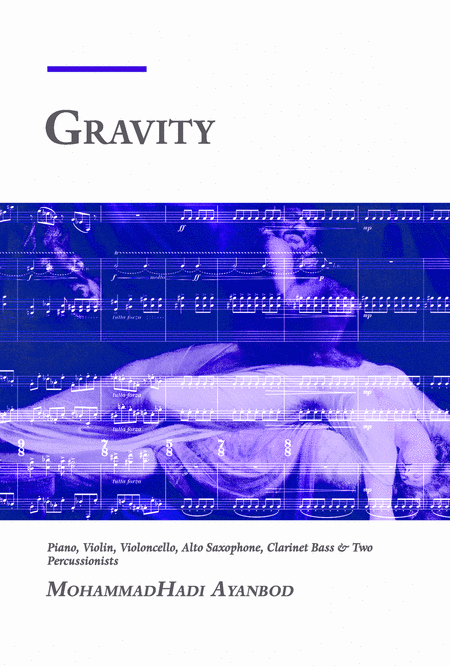Percussion Ensemble - Level 5 - Digital Download SKU: A0.1027778 Composed by MohammadHadi Ayanbod. 20th Century,Contemporary. Score and parts. 25 pages. Rimorarte Edition #5996957. Published by Rimorarte Edition (A0.1027778). In GRAVITY I explored different gravities as forces we not only feel them in every moments of our lives, but also thinking of living without or escaping from them seems impossible. Likewise, those gravities exist in the music, make us feel the music continuous, desirable, logical and an integrated language of art. The exploration of the path from chaos to unity, and from unity to multiplicity, is where the title came from. GRAVITY consists of two main sections. The first section, which shows the fully-grown and flourished musical ecosystem, and the second part; a flashback to just after big-bang, which tries to musicalize the creation of the gravity! In the first section, I’ve used the concept of horizontal and vertical minimalism. At the very beginning of the piece we have a structure that bring the idea of the vertical minimalism out. In every moment, each instrument plays the same note as others. However, the narrative line is divided into different octaves, so, the melody is not the same in spite of the fact that each instrument plays the same tone. This structure also reminds the paradoxical ladder or optical staircase illusion. The narration is built up until it reaches temporal climax. At the same time, this melody starts again from the beginning with some microscopic differences visible vividly to musicians. This semi reciprocating musical narration, could be observed as a musical example of the staircase illusion. After this part, but still in the first section of the music, I’ve used the horizontal (traditional) minimalism idioms to explore the bounding forces present in the music. Although, what interesting here is the creation of synthetic voices which is the result of different amounts of the nuances and different combinations of the sound. For keen ears, it seems like shades of neon lights, penetrate into one another in the scale of time and create a big picture of micro fluctuating objects. In the second section or just after big-bang, I’ve observed and recreate musically, the very moment of creation of the gravity just after the big-bang. Here, we don’t have melody, rhythm, structure, narration and other aspects of the music in the traditional way, although all of them are present in the music. very single sound or noise is meaningful and showing the assemblage process of the forces in the music to create a melody line. I’ve occupied idioms of contemporary Sonorism genre to create the atmosphere. This highly complex texture shows the virtuosity of interpreters and the capability of the instruments in avant-garde literature and extended techniques. The music is concluded by a fast-tempo finale, with the instruction of fortissimo possiblile (as loud as possible). The piece, in fact, will not be finished as a morendo, but, it opens a space for hypothetically living structure; constantly grows, flourishes, shines and decays.
